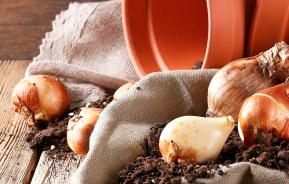We’ve put together 10 ideas to get your garden ready for spring, now that the weather has started to warm up and many of the frosts are coming to an end for parts of the country.
Spring is traditionally when many new flowers and bulbs emerge from the slightly warmed up earth, but can seem a little cold for some gardeners to really get their hands dirty. Getting the preparation work in as early as possible will mean you can reap the rewards later on.
Getting your garden ready for spring should be a pleasure rather than a chore, so these pointers and tips should help you to get your outside space in top shape. So get ready to put on your gloves and warm gardening wear, brave the cold February air and read on...
1. The big clean up
Tidying the garden can seem like a never-ending chore, but if you do make sure it’s done regularly it really shouldn't take you too long.
When you’re ‘pre-spring cleaning’ your garden, you need to remember things like collecting any dead leaves and stalks that have fallen to the ground. These need to be cleared away as they can harbour diseases and allow bacteria to develop and infect your plants. That would be a very bad start to the growing season.
Your clean up could also include your hard landscaping if you have a patio or deck. A good sweep up and clean with plenty of water should do the trick, but if you use cleaning products, make sure you protect your plants.
2. Take care of your lawn
Spring is a good time to feed and rake your lawn and scarify the ground. This will ensure all debris and dead grass cuttings are removed, allowing it to breathe and not become waterlogged.
You can also use this time to level off any uneven areas and add new grass seed, to give your turf a bit of a facelift.
3. Reduce, reuse, compost
One good thing about clearing away all of that organic matter from the garden is that you can put much of it in the composter. In the spring you should make a point of turning over the compost pile. It has been working hard over the winter and you’ll find that the bottom layer will make an excellent mulch - perfect to spread around your flower bed. Found yourself with too much compost? You could always offer some of it to a neighbour.
4. Warm up the kitchen garden
If you're into growing your own, now is the time to start ordering your seeds in. And some vegetables can be sown now undercover.
If you have a greenhouse or ample windowsill, you can start preparing your containers for propagating. Thoroughly clean up any old pots or you can go completely DIY and make your own containers out of newspaper, yoghurt pots or old egg boxes.
5. Get a trim
Many plants could do with a little TLC to get them ready for spring. This might involve re-potting, moving to a more protected area of the garden or trimming the stems to encourage new growth.
If you have a buddleia or roses, for example, these will need to be pruned in the spring, after the frosts have passed. To prepare for this, you can take the time now to identify the plants that need pruning around this time.
6. Banishing weeds and soil preparation
Over the winter, weeds have been enjoying their time in your garden while you’ve been taking a break! As part of your soil preparation, you should remove as many weeds as you can. You might need a weedkiller for this, but you could get away with removing them by hand.
Rake over your soil to maintain airflow and ensure that when you start to plant new perennials they will have the best growing matter possible. New topsoil is a good idea when you are getting your garden ready for spring.
7. Look after garden furniture
Whether made of plastic, wood or wicker, your garden furniture is going to need a bit of TLC. Plastic is pretty easy to revive with some warm soapy water and a sponge. Anything made of timber could need a bit more help. Start with a simple clean and then use the appropriate wood oil to seal it and protect it from the elements.
8. Garden tools
Just like with the pots and containers for your new plants, it’s important to keep your garden tools clean and free from germs.
Any pruning knives and shears will need to be sharpened and oiled to ensure you get a good clean cut when using them on your plants.
9. Get rid of pests
Even though you’ve taken the time to help prevent diseases from spreading throughout your garden with general garden cleanliness, but sometimes pests are still drawn to your plants.
Check underneath leaves for bugs and flies. Some species can be brushed off, but others will need a specialist pest treatment.
10. Protect your fruit
Birds and other animals will be drawn to your fruit trees and bushes as they hunt for food. Cover them with protective netting where possible. Provide birds with an alternative food source like nuts in a bird feeder.








